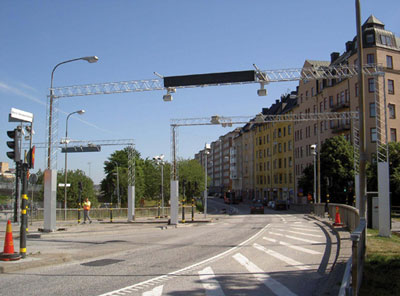Congestion Pricing — A Primer: OverviewExamples From AbroadCentral London
Sign alerting drivers to congestion-pricing area in central London. On February 17, 2003, London implemented an ambitious plan for using pricing to combat congestion in central London.7 The scheme involves a standard per-day charge for vehicles traveling within a zone bounded by an inner-ring road. The congestion charge, together with improvements in public transit financed through revenues from the charging system, led to a 15-percent reduction in traffic in central London, with no significant displacement to local roads outside the area. The majority of ex-car users have transferred to public transport. Travel delays were reduced by 30 percent. Excess waiting time on buses fell by around one-third. Motorists are currently charged £8 a day to drive within the central city zone between 7:00 a.m. and 6:30 p.m. on Monday through Friday. Drivers are able to pay on a daily, weekly, monthly, or annual basis by telephone, regular mail, Internet, or at retail outlets. The registration numbers of their vehicles are entered into a database. A network of fixed and mobile cameras observes the license plates of vehicles entering or moving within the central zone. There are no tollbooths, gantries, or barriers. Drivers do not have to stop. Their license plate numbers are matched against vehicle registration numbers of those who have paid the charge. A number of exemptions from the charging plan are allowed, including a 90-percent discount for residents. Stockholm City CenterStockholm is the most recent large international city to deploy cordon pricing. It was first introduced on a trial basis from January 2006 to July 2006.8 The "trial" results were very favorable, with public acceptance climbing throughout the trial, from under 30 percent approval before the trial to over 52 percent toward the end. There was an immediate 22-percent drop in vehicle trips, a decrease in travel times, and a large shift to public transit—ridership on inner-city bus routes rose 9 percent. Buses, taxis, and distribution vehicles reported reductions in travel times. Traffic accidents involving injuries fell by 5 to 10 percent. Exhaust emissions decreased by 14 percent in the inner-city and by 2–3 percent in Stockholm County. Residents of the City of Stockholm voted for continuation of the system in a referendum on September 17, 2006. It was reinstated on a permanent basis in August 2007. SingaporeTraffic congestion was significantly reduced when peak-period pricing was introduced in downtown Singapore during the morning rush hours in 1975. In spring 1998, the city shifted to a fully automated electronic charging system. In-vehicle electronic devices allow payment by smart card, which is enforced by using cameras and license-plate–reading equipment.9 Variable electronic charges were also introduced on the expressway system, with charges set by time of day to ensure free flow of traffic. The system, the first of its kind in the world, has reduced traffic by 13 percent and has increased vehicle speed by 22 percent. Nationwide Truck Pricing in GermanyIn January 2005, Germany implemented a new system to toll trucks on the autobahns. An average user charge of Euro 0.15 per kilometer (about $0.38 per mile) replaced the previous fee for a time-based permit called "Euro-Vignette." All trucks with a permissible gross weight of 12 or more tons are charged electronically by using GPS. The tolls are based on distance traveled, number of axles, and the vehicle's emissions class. Net toll revenues go toward funding for transportation infrastructure. 
In Stockholm, electronic tag readers and cameras are installed overhead on gantries. |
|
United States Department of Transportation - Federal Highway Administration |
||